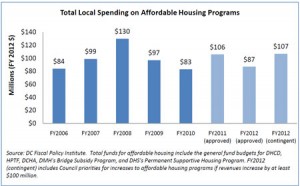Finding affordable housing in Washington, D.C. continues to be difficult for many residents; even five years after the Comprehensive Housing Strategy Task Force (CHSTF) released its plan to address the issue. Today, the Brookings Institution has released a new report that takes a look at DC’s housing policy, in light of recent housing and economic trends, and how much ‘ or how little ‘ progress the District has made on the recommendations laid out by the CHSTF.
The report finds that the District has not implemented many of the CHSTF’s recommendations, but has made progress in several important areas. The national housing crisis and great recession have had a significant impact on DC’s progress, putting the brakes on many of DC’s affordable housing programs while at the same time increasing the need for it. The report lays out five ways that the District can better position itself to build more affordable housing as the economy recovers and also suggests that given the new economic environment, DC use this report as an opportunity to reexamine its overall housing policy.
What progress has DC made on the CHSTF’s major recommendations?
- Recommendation #1: Double expenditures on housing. As frequent readers of the District’s Dime no doubt know, funding for housing programs has not doubled. The District did manage to increase funding by $46 million in the two budgets following the CHSTF report. However, funding quickly fell back to roughly the same level as in FY 2006. This is primarily due to the disastrous effect of the decline in property sales on the Housing Production Trust Fund which is supported by a portion of deed recordation and transfer taxes.

- Recommendation #2: Preserve 30,000 existing affordable housing units and produce 19,000 new long-term affordable units. It is clear that there has been some preservation and production of affordable units over the last five years, yet it is impossible to tell exactly how much (an upper limit estimate is around 11,000 units). The Office of the Deputy Mayor for Planning and Economic Development is developing a database to help answer this question. Unfortunately, it is not yet ready for primetime due to ongoing issues with the data it receives.
- Recommendation #3: Increase homeownership rate to 44 percent and provide additional assistance for tenant purchase. The District has succeeded at raising the homeownership rate to almost 45 percent. However, homeownership has only increased among households making more than $75,000 annually. The Tenant Opportunity to Purchase Program, which helps low-income tenants purchase their buildings, has had its funding cut in the FY 2012 budget.
- Recommendation #4: Support an additional 14,600 extremely low-income renters by adopting a local rent supplement program. The District did create the Local Rent Supplement Program in 2007. However, funding has not been sufficient for it to reach the goals set by the CHSTF. Last year the Council estimated that LRSP was roughly $60 million and 4,000 families behind.
- Recommendation #5: Target existing and new neighborhoods with the potential for sustained improvement and coordinate investments. Most large projects (Anacostia Waterfront, St. Elizabeth’s, the New Communities program, etc.) all struggled due to lack of financing during the recession. As financing unlocks these projects will get off the ground. Inclusionary Zoning took effect late 2009 after some delay, with the first units expected this year.
- Recommendation #6: Integrate housing for persons with special needs into all types of housing throughout the city. Data on special needs housing is lacking, but progress seems mixed. There has been a focus on permanent supportive housing in recent years, though some argue that this has been at the expense of interim and transitional housing. The literally homeless population grew 14 percent in the last four years, due to high unemployment and the housing crisis. A recent report by the U.S. Commission on Civil Rights found that accessibility and unequally geographic distribution of affordable housing are still problems.
Given the city’s challenging budget picture, Brookings’ recommendations focus on short-term, relatively low-cost actions that can be implemented quickly and will put the city in a better position to move aggressively on affordable housing as funding becomes available.
- Upgrade the affordable housing pipeline database maintained by the Office of the Deputy Mayor for Planning and Economic Development (DMPED). The database is an important tool which continues to improve, but it does not yet reliably describe affordable housing activity in the District.
- Develop a unified application process for affordable housing subsidies among DCHA, DCHFA, and DHCD. This would ease the process for developers, reduce redundant or conflicting information on affordable housing developments and allow agencies to engage in a coordinated review of the application.
- Charge DMPED with taking a more forceful role in coordinating among housing agencies. If the District does not want to appoint a Chief of Affordable Housing (one of the recommendations in the 2006 report), it must find another staffing or organizational configuration to ensure that the office effectively coordinates housing policy across agencies.
- Consider options to diversify the funding sources for the Housing Production Trust Fund. For example, the District could dedicate a third of total property taxes collected due to increased property values to affordable housing programs, measured against some baseline year or years. Or it could increase property taxes by 5 percent and dedicate half of new revenues collected to affordable housing. Fixing the Schedule H Tax Credit should also be a priority.
- New economic conditions require that the city rethink its housing policy and strategy. After five years of housing policy informed by the CHSTF report, and facing a different type of economic environment, the city should refine and redefine its housing strategy. We hope that this paper serves as a jumping off point this discussion.
